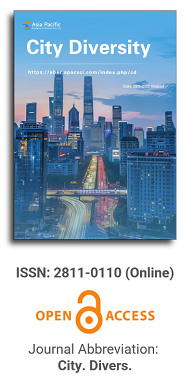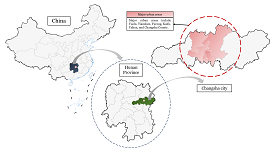
Asia Pacific Academy of Science Pte. Ltd. (APACSCI) specializes in international journal publishing. APACSCI adopts the open access publishing model and provides an important communication bridge for academic groups whose interest fields include engineering, technology, medicine, computer, mathematics, agriculture and forestry, and environment.

As China's pillar industry, the property market has suffered a considerable impact in recent years, with a decline in turnover and many developers at risk of bankruptcy. As one of the most concerned factors for stakeholders, housing prices need to be predicted more objectively and accurately to minimize decision-making errors by developers and consumers. Many prediction models in recent years have been unfriendly to consumers due to technical difficulties, high data demand, and varying factors affecting house prices in different regions. A uniform model across the country cannot capture local differences accurately, so this study compares and analyses the fitting effects of multiple machine learning models using February 2024 new building data in Changsha as an example, aiming to provide consumers with a simple and practical reference for prediction methods. The modeling exploration applies several regression techniques based on machine learning algorithms, such as Stepwise regression, Robust regression, Lasso regression, Ridge regression, Ordinary Least Squares (OLS) regression, Extreme Gradient Boosted regression (XGBoost), and Random Forest (RF) regression. These algorithms are used to construct forecasting models, and the best-performing model is selected by conducting a comparative analysis of the forecasting errors obtained between these models. The research found that machine learning is a practical approach to property price prediction, with least squares regression and Lasso regression providing relatively more convincing results.
Research on parametric landscape design for urban biodiversity conservation
Vol 4, Issue 1, 2023
Download PDF
Abstract
Biodiversity has brought rich material products and non-material benefits to mankind, and is an important support for the sustainable development of human society. Although people realize the importance of improving biodiversity under the pressure of rapid disappearance of biodiversity, few people have fully explored the parametric design of biodiversity in urban landscapes. Therefore, this article briefly describes the development process of urban landscape biodiversity, taking examples of different types and different scales at home and abroad as examples, comparing its parameterized evaluation and design models, and analyzing the parametric design in the urban landscape and the biodiversity target organic ways and means of combination. On this basis, the approach of urban landscape design for biodiversity is explored, its development trend and main problems are prospected, and the corresponding enlightenment for the future development of urban biodiversity and practical reference are provided.
Keywords
References
- Chen L, Ma K. Biodiversity Science: Principle and practice. Shanghai: Shanghai Science and Tech-nology Press, 2001:1–28.
- Chen B. Several ways to protect urban biodiversity in foreign countries. Guangdong Landscape Archi-tecture, 2005(6): 22–25. (in Chinese with English abstract)
- Mccann KS. The diversity-stability debate. Nature, 2000, 405(6783): 228–33.
- Wang Y. Biodiversity framework based on landscape architecture discipline. Landscape architecture, 2014,21 (1): 36–41. (in Chinese with English ab-stract)
- Research progress on distribution patterns of ur-ban biodiversity. Acta ecologica sinica, 2013,33 (4) : 38–51.
- Kremen C. Reframing the land: paring/land: Haring debate for biodiversity conservation[J]. Annals of the New York Academy of Sciences, 2015, 1355(1) : 52–76.
- Chapron G, Kaczensky P, Linnell J, et al. Recovery of large carnivores in Europe's modern hu-man-dominated landscapes. Science, 2014, 346(6216): 1517-1519.
- Letourneau DK, Altieri MA. Environmental Man-agement to Enhance Biological Control in Agroe-cosystems. Handbook of Biological Control, 1999(12): 319-354.
- Huang G, Feng X, Lin F. Effect of parametric design on landscape//20174th International Conference on Education, Management and Computing Technol-ogy (ICEMCT 2017), 2017.
- Beirao J, Duarte J. Urban Grammars: Towards Flex-ible Urban Design//Digital Design: The Quest for New Paradigms (23rd eCAADe Conference Pro-ceedings), 2015.
- Yuan Y, Cheng Y. Process, Logic and Model: Analysis of Parametric Landscape Architecture Planning and Design. Chinese Landscape Archi-tecture, 2018, 34(10): 83-88.
- Ma P. On the concept of biodiversity. Biodiversity, 1993, 1(1): 24-26.
- Ma P, Lou Z, Su R. Review and Prospect of Biodi-versity Research of Chinese Academy of Sciences. Journal of Chinese Academy of Sciences, 2010, 25(6): 634-644.
- Wu J. Landscape Ecology: Concept and Theory. Journal of Ecology, 2000, 19(1): 42-52.
- Yue T, Haber W, Grossmann W. Discussion on models for species diversity and suggestion on a compre-hensive model. ECOMOD, 1998.
- Zhao M, Liu Z. Discussion on the development status of urban biodiversity conservation planning at home and abroad and its planning approaches and methods. Beijing: China Sustainable Development Forum, 2009.
- Yu K, Li D, Duan T. Landscape planning approach to biodiversity conservation. Biodiversity, 1998, 6(3): 205-212.
- Safriel U, Adeel Z, Niemeijer D, et al. Ecosystems and human well-being: Current state and trends[J]. Journal of Bacteriology , 2005, 1(5):1387-1404.
- Emmerson M, Morales MB, Oñate JJ, et al. How Agricultural Intensification Affects Biodiversity and Ecosystem Services. Advances in Ecological Re-search, 2016, 55: 43-97.
- Yang F, He D. Effects of habitat fragmentation on biodiversity. Annual Review of Ecology Evolu-tion & Systematics, 2003, 34(2): 487-515.
- Wang Y, Li J, Li S, et al. Effects of human disturbance on plant diversity in urban areas. Journal of Ecology, 2004, 23(2): 102-104.
- Kremen C, Merenlender AM. Landscapes that work for biodiversity and people. Science 2018, 362(6412): eaau6020.
- Uslu A, Shakouri N. Urban Landscape Design and Biodiversity//Ozyavuz M. Advances in Landscape Architecture. London: Intech Open, 2013.
- Chen B, Bao Z. Comprehensive application of landscape ecological planning approach in biodi-versity conservation. Chinese Landscape Architec-ture, 2003, 19(5): 52-54.
- Sukopp H, Weiler S. Biotope mapping and nature conservation strategies in urban areas of the Federal Republic of Germany. Landscape and Urban Plan-ning, 1988, 15(1-2): 39-58.
- Liu H. European and Dutch experience in planning of ecological network of connection and coopera-tion. Chinese Landscape Architecture, 2009, 25(9): 31-35.
- Chen B. Urban biodiversity and its conservation approache. Zhejiang Agricultural Journal, 2009(1): 71-76.
- Yu K. Security patterns and surface model in land-scape ecological planning. Landscape and Urban Planning, 1996, 36(1): 1-17.
- Liu S, Zhang S. Digital Landscape Education and Future Development of Digital Landscape: En-lightenment from the International Conference on Digital Landscape. Chinese Landscape Architecture, 2015, 31(4): 77-79.
- Yuan Y. Research on Parametric Landscape Archi-tecture Planning and Design Mechanism Based on Coupling Principle. Nanjing: Southeast University, 2016.
- Bao R. Discussion on Computer Aided Landscape Architecture Planning and Design Strategy. Journal of Beijing Forestry University: Social Science Edi-tion, 2013, 12(1): 38- 44.
- Kuang W. Overview and thinking on the develop-ment of "parametric" planning and design of land-scape architecture. Landscape Architecture, 2013, 20(1): 58-64.
- Piroddi C, Teixeira H, Lynam CP, et al. Using eco-logical models to assess ecosystem status in support of the European Marine Strategy Framework Di-rective. Ecological Indicators , 2015, 58: 175-191.
- Popov B, Nikolov N. LAS [Landscape Architectural Simulations] How Can Netlogo Be Used In The Landscape Architectural Design Process?. New Zealand: Unitec Institute of Technology, 2007.
- Connery K. Biodiversity and Urban Design: Seeking an Integrated Solution. Journal of Green Building, 2009(2): 23-38.
- Aecom. Landscape Biodiversity Planning& Design System (Technical Report) 2013.
- Charalampidis E, Tsalikidis I. A parametric land-scape design approach for urban green infrastructure development//Changing Cities II: Spatial, Design, Landscape & Socioeconomic Dimensions, 2015.
- Busón IL, Polites M, Calvet MV, et al. A Computa-tional Approach to Methodologies of Landscape Design//Humanizing Digital Reality. Singapore: Springer, 2018: 657-670.
- Hunter M. Using Ecological Theory to Guide Urban Planting Design An Adaptation Strategy for Climate Change. Landscape Journal, 2011, 30(2): 173-193.
- Fernandes C, Gomes AL, Farinha-Marques P, et al. Merging Practice and Science to Improve Biodi-versity in the Planting Design of Public Green Spaces//Landscapes of Conflict. ECLAS Conference, Ghent: University College Ghent, 2018.
- Wang Y, Wang Min. Experience and Enlightenment of American Biodiversity Planning and Design. Chinese Garden, 2011, 27(2): 45-48.
- Fu B, Yu D, Lv N. Indicator system for as-sessing biodiversity and ecosystem services in China. Chinese Journal of Ecology, 2017, 37(2): 341-348.
- Li Q, Zhu J, Xiao W. Biodiversity and ecosystem services: Relationships, trade-offs and management. Chinese Journal of Ecology, 2018, 38(8): 15-26.
- Ding S, Cao X. Let the City Ecology: The Principles and Methods of Landscape Ecology for Urban Bi-odiversity Conservation. Ecological Economy, 2003(4): 32-35.
Supporting Agencies
Copyright (c) 2023 Huaize Ye, Jun Zhai

This work is licensed under a Creative Commons Attribution 4.0 International License.

This site is licensed under a Creative Commons Attribution 4.0 International License (CC BY 4.0).

Prof. Mehmet Cetin
Kastamonu University,
Turkey
Polish Scientific Bibliography

